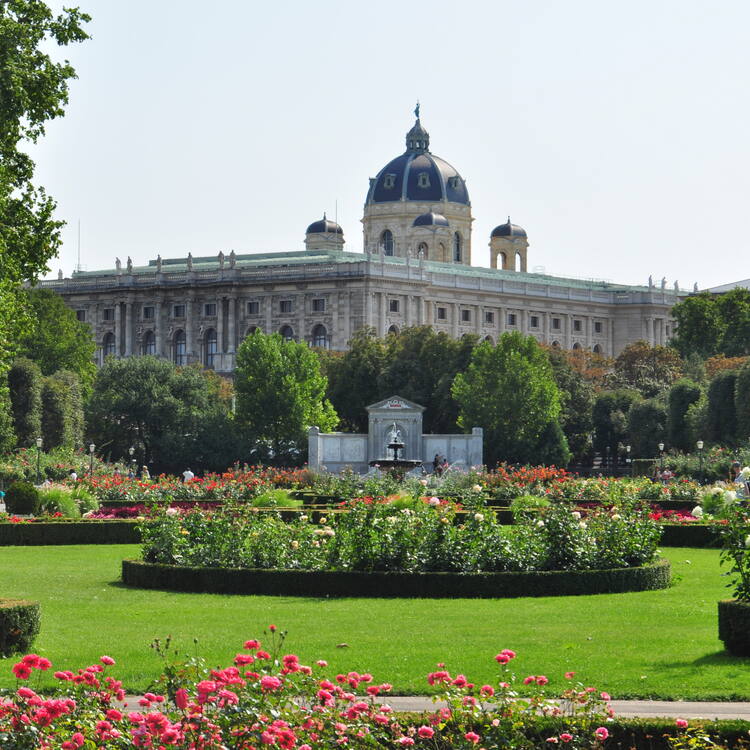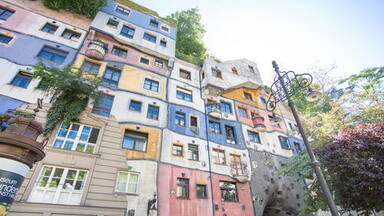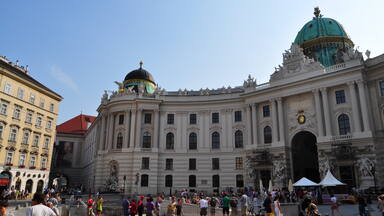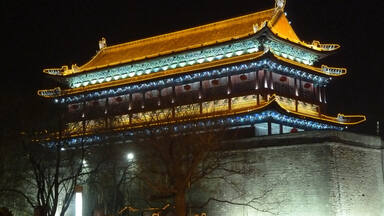Historic Centre of Vienna
Historic Centre of Vienna
Vienna developed from early Celtic and Roman settlements into a Medieval and Baroque city, the capital of the Austro-Hungarian Empire. It played an essential role as a leading European music centre, from the great age of Viennese Classicism through the early part of the 20th century. The historic centre of Vienna is rich in architectural ensembles, including Baroque castles and gardens, as well as the late-19th-century Ringstrasse lined with grand buildings, monuments and parks.
Description is available under license CC-BY-SA IGO 3.0
Centre historique de Vienne
Vienne s’est développée à partir des premiers établissements celtes et romains, en passant par la ville médiévale puis baroque, jusqu’à devenir la capitale de l’Empire austro-hongrois. Elle a joué un rôle fondamental en tant que haut lieu de la musique européenne et demeure associée aux grands compositeurs, du classicisme viennois à la musique moderne. Le centre historique de Vienne abrite une grande variété d’éléments architecturaux, notamment des palais baroques et des jardins ainsi que l’ensemble de la Ringstrasse datant de la fin du XIXe siècle.
Description is available under license CC-BY-SA IGO 3.0
وسط فيينا التاريخي
تطوّرت فيينا بدءاً من اولى المؤسسات السلتية والرومانية مروراً بالمدينة في القرون الوسطى ومن ثم الباروكية إلى أن اصبحت عاصمة الإمبراطورية النمساوية المجرية. لقد لعبت دوراً اساسياً كمركز مهم في عالم الموسيقى الأوروبية ولا تزال مرتبطة باسم مؤلفين كبار منذ الكلاسيكية النمساوية إلى الموسيقى الحديثة. ويضمّ وسط فيينا التاريخي مجموعة من العناصر الهندسية ولا سيما القصور الباروكية والحدائق، بالإضافة إلى الرينغستراس الذي يعود إلى نهاية القرن التاسع عشر.
source: UNESCO/CPE
Description is available under license CC-BY-SA IGO 3.0
维也纳历史中心
维也纳是从早期哥特人和罗马人聚落发展起来的,后来成了一个中世纪巴洛克风格的城市——奥匈帝国首都。从伟大的维也纳古典乐派时代开始一直到20世纪初,维也纳一直作为欧洲音乐中心发挥着重要的作用。维也纳历史中心汇集了大量建筑艺术,包括巴洛克风格的城堡和花园,还有建于19世纪晚期的环城大道,两旁是宏伟的楼群,也有古迹和公园。
source: UNESCO/CPE
Description is available under license CC-BY-SA IGO 3.0
Исторический центр Вены
На развитие Вены наложили отпечаток различные исторические эпохи. В разное время Вена и раннее кельтское, и древнеримское поселение, и средневековый и барочный город, столица Австро-Венгрии. Со времен венского классицизма до начала ХХ в. город играл важную роль в качестве ведущего музыкального центра Европы. Исторический центр Вены богат архитектурными ансамблями, включая барочные дворцы и парки, а также Ринг (Рингштрассе) конца XIX в, с расположенными вдоль него величественными зданиями, памятниками и парками.
source: UNESCO/CPE
Description is available under license CC-BY-SA IGO 3.0
Centro histórico de Viena
Viena se fue desarrollando desde los primeros asentamientos celtas y romanos en su territorio y a través de la construcción sucesiva de la ciudad medieval y la barroca, hasta convertirse en la capital del Imperio Austrohúngaro. La ciudad ha desempeñado un papel fundamental como centro importante de la música europea y su nombre va asociado a grandes compositores, desde el clasicismo vienés hasta la música de principios del siglo XX. Su centro histórico alberga una gran variedad de jardines y monumentos arquitectónicos, principalmente palacios barrocos, así como el conjunto de la Ringstrasse, que data de fines del siglo XIX.
source: UNESCO/CPE
Description is available under license CC-BY-SA IGO 3.0
ウィーン歴史地区
source: NFUAJ
Historisch centrum van Wenen
Source: unesco.nl
Outstanding Universal Value
Brief synthesis
Vienna, situated on the Danube River in the eastern part of Austria, developed from early Celtic and Roman settlements into a medieval and Baroque city, eventually becoming the capital of the Austro-Hungarian Empire. It played an essential role as the leading European music centre, hosting major personalities in the development of music from the 16th to the 20th centuries, particularly Viennese Classicism and Romanticism, consolidating Vienna’s reputation as the ‘musical capital’ of Europe. Vienna is also rich in architectural ensembles, particularly Baroque mansions and gardens as well as the late 19th-century Ringstrasse ensemble lined with grand buildings, monuments, and parks. The property consists of the city’s medieval core (based on the Roman settlement), the principal Baroque ensembles with their axial layouts, and the Gründerzeit constructions from the beginning of the modern period.
At the beginning of the 12th century the settlement here expanded beyond the Roman defences, which were demolished. During the Ottoman conflicts in the 16th and 17th centuries, the medieval town’s walls, which surrounded a much larger area, were rebuilt and provided with bastions. This remained the core of Vienna until the medieval walls were demolished in the second half of the 19th century. The inner city contains a number of medieval-era buildings, including the Schottenkloster, the oldest monastery in Austria, the churches of Maria am Gestade (one of the main Gothic structures), Michaelerkirche, Minoritenkirche and Minoritenkloster from the 13th century, and St Stephen’s Cathedral, which dates from the 14th and 15th centuries. The same period also saw the construction of civic ensembles, such as initial parts of the Hofburg Palace. Whereas the monastic complexes were generally built of stone, becoming part of the defences of the medieval city, the residential quarters were of timber and suffered frequent fires.
In 1683, Vienna became the capital of the Habsburg Empire and developed rapidly, becoming an impressive Baroque city. The Baroque character was expressed particularly in the large palace layouts such as the Belvedere Palace and garden ensemble. A growing number of new palaces were built by noble families, many existing medieval buildings, churches, and convents were altered and given Baroque features, and additions were made to representative administrative buildings. Several historic Viennese buildings are now associated with the residences of important personalities such as Mozart, Beethoven, and Schubert, when the city played an essential role as a leading European centre for music.
A new phase in the history of Vienna took place when its 34 suburbs were incorporated into the city and the emperor ordered the demolition of the fortifications around the inner city. The opportunity was taken to create one of the most significant 19th-century ensembles in the history of urban planning, which greatly influenced the rest of Europe in this crucial period of social and economic development. In 1874, the Hofburg complex was extended with the addition of the Neue Hofburg, an ‘Imperial Forum’, and joined with large museum complexes into a single ensemble. The Burgtheater, parliament, town hall, and university formed another ensemble linked with these structures. To this was added the opera house as well as a large number of public and private buildings along the Ringstrasse, on the line of the demolished city walls. The late 19th and early 20th centuries testify to further creative contributions by Viennese designers, artists, and architects in the periods of the Jugendstil (Art Nouveau), the Secession, and the early Modern Movement in architecture.
Criterion (ii): The urban and architectural qualities of the Historic Centre of Vienna bear outstanding witness to a continuing interchange of values throughout the second millennium.
Criterion (iv): Three key periods of European cultural and political development – the Middle Ages, the Baroque period, and the Gründerzeit – are exceptionally well illustrated by the urban and architectural heritage of the Historic Centre of Vienna.
Criterion (vi): Since the 16th century Vienna has been universally acknowledged to be the musical capital of Europe.
Integrity
Within the boundaries of the 371 ha Historic Centre of Vienna are located all the attributes that sustain its Outstanding Universal Value, including its architectural and urban qualities and layout, and that illustrate its three major phases of development – medieval, Baroque, and the Gründerzeit – that symbolize Austrian and central European history. The Historic Centre of Vienna has also maintained its characteristic skyline. The 462 ha buffer zone protects the immediate setting of the inscribed property.
Authenticity
The property is substantially authentic in terms of its location, its forms and designs, and its substance and materials. This authenticity resides largely in the overlapping and multi-layered interweaving of urban buildings, structures, and spaces. The property has to a remarkable degree retained the architectural elements that demonstrate its continuous interchange of values through authentic examples from the above-mentioned three key periods of European cultural and political development. In addition to the architectural elements, the Historic Centre of Vienna has retained its role as the music capital of Europe.
The historic urban fabric of the Historic Centre of Vienna is thus informed by this ongoing interchange, which has caused the urban landscape to evolve and grow over time, reflected in the new, emerging skyline outside the buffer zone. Vienna’s continuing development requires a very sensitive approach that takes into account the attributes that sustain the Outstanding Universal Value of the property, including its visual qualities, particularly regarding new high-rise constructions.
Protection and management requirements
About 75% of the property is in private ownership, 18% is publicly owned, and 7% is owned by the Roman Catholic Church. Various legal instruments at both federal and municipal/provincial levels protect the Historic Centre of Vienna and its buffer zone. These include the Federal Monument Protection Act (Federal Law Gazette No. 533/1923, the most recent amendment entering into force on 1 January 2000), and the municipal Building Code, with its Amendment on Old Town Conservation (Vienna Law Gazette No. 16/1972). Parts of Vienna fall under the regulations of the Vienna Nature Conservation Act (from 1998). Other legal instruments, such as the Garages Act and the Tree Preservation Act, are also relevant.
In addition to these regulations, the Province of Vienna has adopted a Land Use Plan and Urban Development Plans as planning instruments. The Land Use Plan, which on a scale of 1:2000 is a more precise version of the Urban Development Plan, divides the metropolitan area into green zones, development zones, and infrastructure zones. The Urban Development Plan lays down the spatial dimensions of the protection zones as defined under the Vienna Old Town Conservation Act. The Management Plan, which was elaborated in 2002, refers to the two World Heritage properties in Vienna (Historic Centre of Vienna, and Palace and Gardens of Schönbrunn). The plan fulfils objectives related to formalizing the procedures for the legal protection of cultural properties, and to defining the urban administrative structures for cultural assets as well as the necessary measures for the preservation of the cultural heritage (heritage which has to meet the requirements of ‘authenticity’, design, material, and artisanship).
Sustaining the attributes that support the Outstanding Universal Value, authenticity, and integrity of the property over time will require addressing the challenges related to development pressures, visual impacts, and modernization of the historic fabric that arise within the context of urban development in a prosperous capital city. Such challenges led to the adoption in 2005 of the internationally recognised “Vienna Memorandum” on managing historic urban landscapes. Since then, planning authorities in Vienna have paid particular attention to new, sustainable, appropriate conservation policies. As a result, the Urban Development Plan was revised in line with the stipulations of the Memorandum. Efforts must be continued to ensure the coherence of new developments with the Outstanding Universal Value of the Historic Centre of Vienna, especially of high-rise buildings outside the buffer zone.

 View photos from OUR PLACE the World Heritage collection
View photos from OUR PLACE the World Heritage collection



